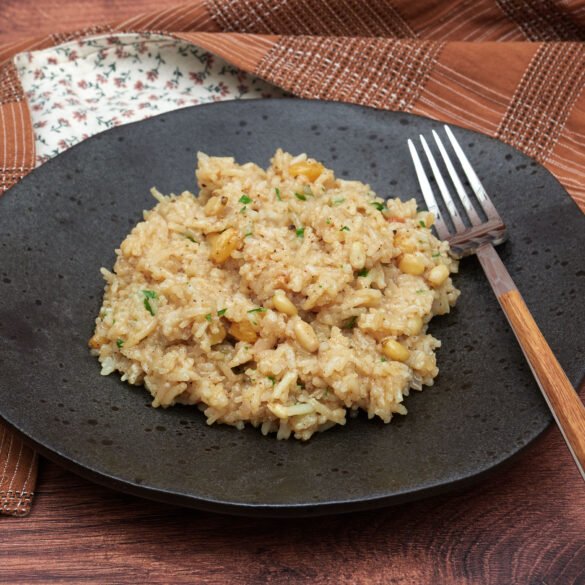In my hometown, I’m lucky to have a rather fancy butcher shop. They are excellent when it comes to pork, minced meat for kebabs, and their own homemade specialties. Most importantly, everything is always fresh. I’ve made it a habit to stop by every couple of days, since we prefer cooking with the freshest cuts of meat possible.
On my last visit, I picked up some kofta and an Adana kebab. The kebab was for me, as I’m the only one in the family who enjoys the spicy kick, and I thought it would be the perfect occasion to have a little Turkish night at home.
The skewers themselves are easy enough to prepare, but instead of serving them with the usual French fries, I went looking for an authentic Turkish side dish.
After browsing through several Turkish recipe sites, I came across a fragrant rice dish with pine nuts and raisins called Iç Pilav. There are many variations of this pilaf — some include lamb offal such as liver or heart — but I decided on a vegetarian version, since we already had plenty of meat on the table.
Traditionally, Iç Pilav is used as a stuffing for chicken, turkey, or lamb, but it also works beautifully as a stand-alone dish. The flavor is delicate yet layered: slightly sweet, gently spiced, and full of character. The pine nuts add a subtle crunch, the raisins and cinnamon bring a hint of sweetness, while allspice contributes a warm, peppery kick.
Pine nuts (also known as pinoli in Italian) are the edible seeds of certain species of pine trees. They are a staple in Mediterranean cuisine and a key ingredient in classic pesto. You can find them online or in health food stores, and they’re a wonderful pantry item to elevate both sweet and savory dishes.
ad

Ingredients
- 1 medium white onion
- 2 tablespoons olive oil
- 3 tablespoons pine nuts
- 2 tablespoons raisins
- 1/2 teaspoon allspice
- 1 teaspoon cinnamon
- 350 grams long grain rice - I used basmati rice
- 750 ml water
- 1/2 teaspoon salt
- 1 tablespoon finely chopped parsley
Instructions
Rinse the rice thoroughly, changing the water two or three times until it runs clear. Then cover with fresh water and let soak for 10–15 minutes. This step removes excess starch, helping to prevent the grains from sticking together. Leave to drain afterwards.
Bring the water or vegetable stock to a gentle boil in a separate pot.
Finely chop the onion and sauté it in 2–3 tablespoons of olive oil until soft and translucent.
Add the pine nuts and sauté until they begin to turn golden brown.
Add the allspice, cinnamon, salt, and the raisins. Add the drained rice, stirring so that each grain is coated in the oil and spices. Cook for 2–3 minutes, stirring occasionally.
Pour in the hot water or stock and bring to a boil. Cover with a lid, reduce the heat to low, and cook for about 15 minutes, or until the liquid is fully absorbed.
Turn off the heat. Place a clean kitchen towel or several layers of paper towel over the pan, then put the lid over. Let the rice rest for 10–15 minutes to absorb the steam.
Fluff the rice gently with a fork, stir in the finely chopped parsley, and serve warm.
Notes
Small black currants are ideal for this recipe.
The recipe works very well with non-sticky rice. Basmati is best, but Jasmine rice works just as well.
Vegetable stock can be used instead of water. In this case, take into account the salt content of the vegetable stock.
You can vary the amount of spices to suit your taste. If you are making this rice for the first time, I suggest starting with half the amount of spices and then adjusting the recipe to your liking.
Allspice is usually found in whole form, because once ground, it quickly loses its aroma. You will need to grind it yourself using a coffee or spice grinder, or you can crush it very finely in a mortar.
Allspice (Pimenta dioica) is widely available across Europe, often sold under different names such as Piment, Pimento, Pepe della Giamaica, or Piment de la Jamaïque

